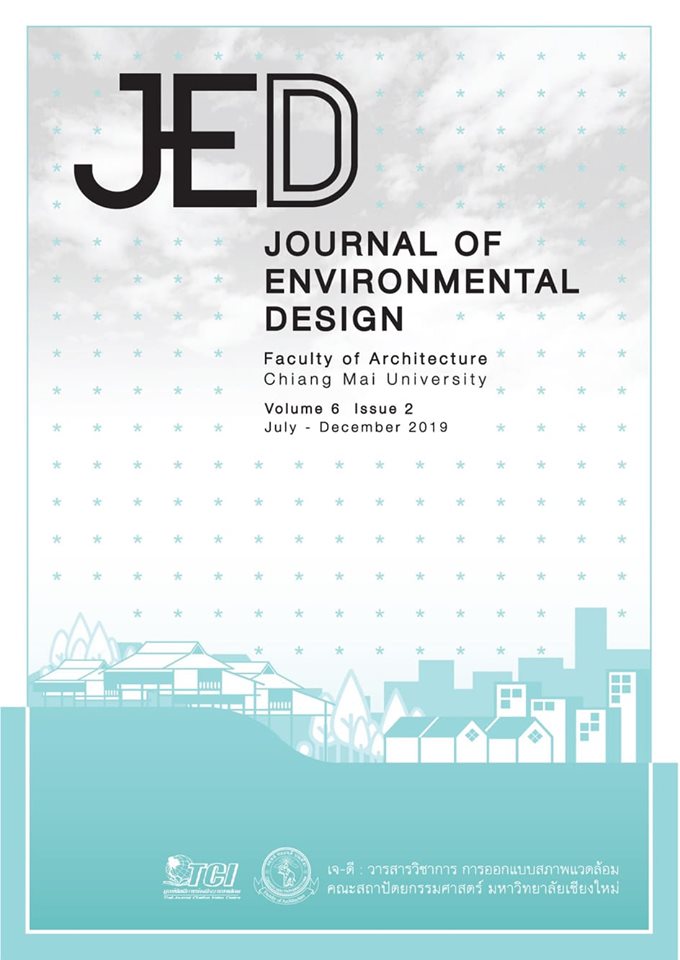พื้นที่ในชีวิตประจำวันของชุมชนละแวกบ้านในเขตกำแพงเมืองเชียงใหม่
Main Article Content
บทคัดย่อ
ละแวกบ้านเป็นหน่วยทางสังคมที่สำคัญ เป็นพลังสำคัญในการสร้างความรู้สึกเป็นเจ้าของซึ่งจะนำไปสู่การพัฒนาพื้นที่ละแวกบ้านและพื้นที่เมืองโดยส่วนรวม เมืองเก่าเชียงใหม่เป็นพื้นที่ที่มีประวัติศาสตร์มายาวนาน เป็นแหล่งมรดกทางวัฒนธรรมที่สำคัญ ประกอบด้วยละแวกบ้านดั้งเดิม
เป็นจำนวนมากที่กำลังเปลี่ยนแปลงไปในทางลดความสำคัญของละแวกบ้านลง งานวิจัยชิ้นนี้ให้ความสำคัญกับพื้นที่ในชีวิตประจำวันของละแวกบ้านวัดล่ามช้างในเขตเมืองเก่าเชียงใหม่ ที่ได้จากการสังเกตการใช้พื้นที่สาธารณะของคนทุกกลุ่มในละแวกบ้าน เนื่องจากสามารถนำมาวิเคราะห์ความสัมพันธ์ของกลุ่มคนในละแวกบ้านได้และยังใช้เป็นเครื่องบ่งบอกความเป็นสถานที่ของละแวกบ้านได้อีกด้วย ความรู้ความเข้าใจนี้่จะสามารถใช้เป็นเครื่องมือในการสร้างสรรค์พื้นที่แห่งโอกาส สำหรับคนทุกกลุ่มอย่างเท่าเทียมกัน เพื่อสนับสนุนใ่ห้ผู้คนในละแวกบ้านดั้งเดิมมีพื้นที่ของตนในเขตเมืองเก่า เพราะผู้คนและความสัมพันธ์ทางสังคมของผู้คนนี้เองที่จะเป็นปัจจัยสำคัญในการรักษาอัตลักษณ์ของเมืองเอาไว้ให้เป็นมรดกทางวัฒนธรรมที่ส่งต่อถึงลูกหลานสืบไป
Article Details
เอกสารอ้างอิง
Askew, M. (2002). Bangkok: place, practice and representation. London: Routledge.
Blowers, A. (1973). The neighbourhood: exploration of a concept. In Brown, H., et al. (Eds.). The city as a social system. (pp.49-90). Miton Keynes: Open University Press.
Bourdieu, P. (1989). Social space and symbolic power. Sociological Theory, 7 (1), 14-25.
Duangthima, W. and Tansukanun, P. (2018). Neawtang karn pattana lawaek ban lae yan nai mueang Chiang Mai. (In Thai) [Development of neighbourhood and districts of Chiang Mai city]. Journal of the Faculty of Architecture, King Mongkul’s Institute of Technology Ladkrabang, 27 (2), 134-151.
Farr, D. (2008). Sustainable urbanism: urban design with nature. Hoboken, New Jersey: John Willey & Sons.
Fisher, R. (1985). Neighborhood organizing and urban revitalization: a historical perspective. Journal of Urban Affairs, 7 (1), 47-54.
Gehl, J. (2011). Life between buildings: using public space. Washington, DC: Island.
Giddens, A. (1995). The constitution of society: outline of the Theory of Structuration. Cambridge: Polity.
Hillier, B. & Hanson, J. (1984). The social logic of space. Cambridge: Cambridge University Press.
Hillery, A. G. (1955). Definitions of community: areas of agreement. Rural Sociology Journal,
20 (2), 111-123.
Jacobs, J. (1961). The death and life of great American cities. New York: Random House.
Knox, P. L. (1994). Urbanization: an introduction to urban geography. Michigan: Prentice Hall Inc.
Knox, P. L. & Pinch, S. (2000). Urban social geography: an introduction. New Jersey: Prentice Hall.
Kon Jai Baan. (2017). Rai ngan karn sueksa chumchon nai khet kamphaeng mueang Chiang Mai (In Thai) [The report on communities within Chiang Mai city wall]. n.p.: The Chiang Mai World Heritage Initiative Project.
Massey, D. (2005). For space. London: Sage.
Massey, D., Allen, J., & Pile, S. (1999). City worlds. London: Routledge.
Mateo-Babiano, I. B. (2012). Public life in Bangkok’s urban spaces. Habitat International, 36 (4), 452-461.
Mumford, L. (1937). What is a city?. Retrieved February 2, 2019 from https://studylib.net/doc/13464602/“what-is-a-city%3F”-architectural-record-lewis-mumford-edit...#
Mumford, L. (1954). The neighbourhood and the neighbourhood unit. Town Planning Review, 24 (4), 256-270.
Natsupa, C. (2014). Karn pen samai mai kab naewkid chumchon (In Thai). [Modernization and the community concept]. Bangkok: Sang San.
Oranratmanee, R. & Sachakul, V. (2014). Streets as public spaces in Southeast Asia: case studies of Thai pedestrian streets. Journal of Urban Design, 19 (2), 211-229.
Paksukchareon, K. (2008). Soi lad prayad palang ngan. (In Thai). [Small public spaces and social spaces for Thai communities]. Retrieved February 2, 2019 from https://www.tuda.or.th/index.php/2018/08/02/00000003/
Perry, C. (1929). City planning for neighbourhood life. Social Forces, 8 (1), 98-100.
Tansukanun, P. & Duangthima, W. (2012). Neawtang karn pattana kwam pen yan lak miti khong mueang Chiang Mai. (In Thai) [The multi-layered districts of Chiang Mai city]. Chiang Mai: Pu-Pae Printing.
Tansukanun, P. (2004). Lan wat: miti tang kaiyaphab lae sangkom khong wat nai muang yai lae muang lek tang phaknuea khong prathet Thai. (In Thai) [The connection beyond sacred architecture: an analysis through spatial structure and daily rhythm of the temple grounds in a regional city and a small town in the North of Thailand]. Built Environment Inquiry, 3 (1), 59–77.
Tansukanun, P. (2018). Kwam rusuek pen sathantee lae karn pattana yang yangyuen khong song chumchon lawaek ban nai mueang Chiang Mai. (In Thai) [The two local neighbourhoods of Chiang Mai: sense of place and sustainable development]. Built Environment Inquiry, 17 (2), 45-68.
Tansukanun, P. & Duangthima, W. (2017). Kwam rusuek pen sathantee khong chumchon lawaek ban nai khet mueang prawattisat Chiang Mai. (In Thai) [A sense of place and neighbourhoods in historic cities: the case of Chiang Mai, Thailand]. Built Environment Inquiry, 16 (1), 85-107.


